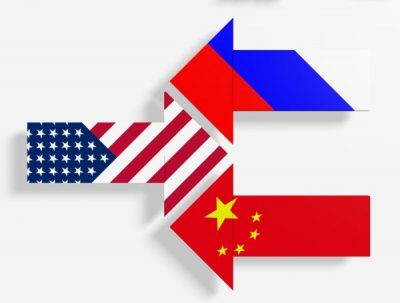Economic Globalization: Russia, China, and the US’ “Integration Models” Aren’t Mutually Exclusive

Russia, China, and the US are each promoting three separate integration models emphasizing conservatism, connectivity, and competitiveness, respectively, but each of their defining characteristics don’t make them mutually exclusive of one another, and it would be to the benefit of every country that they incorporate parts of all three as they navigate the ongoing global systemic transition.
One of the megatrends of contemporary International Relations is the consolidation of regional and trans-regional blocs, with the EU being the perfect (or rather, imperfect) example of this in practice. There seems to be no alternative to countries teaming up with one another in order to collectively improve their prospects of economically succeeding against their larger peers, with the most popular argument being that comparatively smaller countries would eventually stand no chance of surviving if they indefinitely opt out of this framework. The EU model masquerades as an egalitarian community of equal states but has been exposed as nothing more than a structural means for Germany to conquer the continent without a shot and seize control of its many countries’ economies, which has thus discredited this approach in the eyes of average citizens across the world and created the demand for alternative models to emerge elsewhere.
The three most far-reaching and all-inclusive ones being promoted at the present time are led by Russia, China, and the US, with each Great Power’s approach emphasizing conservatism, connectivity, and competitiveness, respectfully, while each also eschews any overtly political agenda such a creating an analogue to the European Parliament.
Russia’s vision of a Greater Eurasian Partnership is for every country in the supercontinent to retain its national traditions and culture while simultaneously promoting the free movement of goods and people across their borders, with no one state being able to impose its ideological vision of society onto others like Germany has attempted to do with the rest of Europe as regards its hyper-liberal ideas. China, meanwhile, places its focus on promoting physical connectivity through large-scale infrastructure projects that collectively constitute its worldwide Belt & Road Initiative (BRI), whereas the US under Trump nowadays believes in what he describes as free but fair trade that safeguards the competitiveness of strategic industries.
While they prioritize different spheres of importance, these three models’ defining characteristics don’t make them mutually exclusive of one another, and it would be to the benefit of every country that they incorporate parts of all three as they navigate the ongoing global systemic transition. In fact, it can even be argued that they complement one another and form separate parts of the same global development whole. The most sustainable solution to Huntington’s fearmongering prediction about a supposedly inevitable “Clash of Civilizations” is to preserve each one’s uniqueness by not allowing any given country to impose its ideological views onto others, ergo the importance of Russia’s social conservative model. As for China’s, it fulfills the unquestionable need of providing long-term financing for ambitious connectivity projects that otherwise couldn’t be afforded by most of the host states, all with a view towards bringing the world closer together with time. Concerning the US, there’s certainly wisdom in promulgating some degree of protectionist policies in order to protect strategic industries.
Taken together, the ideal scenario would be if the seemingly inevitable outcome of several megablocs eventually sprouting up across the world resulted in each of them respecting one another’s cultures (both between themselves and between their own members), connecting with each other through state-of-the-art transport infrastructure, and preserving the competitive edge of their most strategic industries. Thus far, the most likely chance of this happening in the coming future will probably occur through the planned pairing of the Eurasian Union and BRI, which would create the structural basis of the Greater Eurasian Partnership that envisages connecting with ASEAN, the EU, the SCO, and beyond. It’s unrealistic to expect that its many disparate members will ever truly agree to the free trade of all goods and services between them owing to their preexisting socio-economic disparities, so it should be taken for granted that some degree of protectionism will remain in accordance with the American model, while the Russian and Chinese ones will see the preservation of national cultures and their linkage through newly constructed physical infrastructure.
Looking forward, it can therefore be said that the Eurasian Union’s Central Asian, Siberian, and Far Eastern frontiers along the Chinese periphery will become the test cases for implementing this vision in practice upon that bloc’s pairing with BRI, after which the experiences that are learned can then be applied elsewhere throughout the supercontinent as this unprecedented process expands beyond its dual cores to eventually encompass the rest of the hemisphere. The US, however, will likely regard this historic development as a threat to its global standing per the strategic precept first put forth by former National Security Advisor Brzezinski in his 1997 book about “The Grand Chessboard”, so it’s expected that it’ll do whatever it can to stop it ahead of time, likely relying on Kissingerian “triangulation” between itself, China, and India to drive a deeper wedge between these two nominal BRICS and SCO partners in the New Cold War the same way as it did between China and the USSR in the Old Cold War, all to divide and rule Eurasia for its own benefit once again.
Note to readers: please click the share buttons above or below. Forward this article to your email lists. Crosspost on your blog site, internet forums. etc.
This article was originally published on OneWorld.
Andrew Korybko is an American Moscow-based political analyst specializing in the relationship between the US strategy in Afro-Eurasia, China’s One Belt One Road global vision of New Silk Road connectivity, and Hybrid Warfare. He is a frequent contributor to Global Research.
Featured image is from The Unz Review

